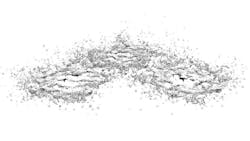About the author:
Cristina Tuser is associate editor of WWD. Tuser can be reached at [email protected]
A check valve is a one-way or nonreturn valve that opens with fluid movement and pressure, and closes to prevent backflow of the pressure to upstream equipment including pumps and compressors.
What is the Purpose of a Check Valve?
Check valves allow fluid to flow in only one direction. They have two ports: one as an inlet for the media and one as the output for the media.
When Should Check Valves be Used?
Check valves are useful in situations where there is a concern over damage to a pump from backpressure from the distribution system, or to ensure backflow from a water source does not contaminate treated or potable water sources.
They are particularly useful in applications that backflow would cause an issue. If the backflow is contaminated, the media upstream is contaminated as well. As such, these valves are very common in drinking water distribution systems and treatment plants.
Another instance in which check valves are used is for centrifugal pumps, which are not self-priming, so the valves are essential for keeping water in the pipes.
Where is the Check Valve Located?
Check valves are often placed on the outlet side of a pump, to protect the pump from backflow. Depending on the application, parameters for how far the valve should be placed from other equipment may be required. As such, it is recommended to consult the valve manufacturer, an engineer or a consultant to ensure proper location for optimal use of the valve.
What Are the Different Types of Check Valves?
There are different types of check valves for varying operations and applications.
Globe Style Check Valve
Globe valves have cage-guided, top-guided, split-body, and top-and-bottom-guided configurations of body type and plug guiding. These valves are usually used in plant piping and are used for regulating flow or pressures and complete shutoff of flow when needed.
Wafer Style Check Valve
Wafer style check valves are different from swing check valves in their body design. They use a wafer-thin disc that allows flow to only go in one direction, much like all check valves. However, because the disc is thinner, it makes these valves ideal for tight spaces where swing check valves and other styles may be too large.
Swing Check Valve
Similar to a wafer style, swing check valves use a disc inside the valve to allow or stop the flow of the piping system. Once the fluid flows through, the pressure forces the disc to open and stay open, and as the pressure decreases, the valve disc closes, which stops the flow of the fluid from reversing. These valves are typically used in sizes of 2 inches or larger and can be installed in both horizontal and vertical positions. These are not suitable for pulsating flow.
Non Slam Axial Check Valve
A non slam axial check valve is a valve that closes abruptly because of gravity, causing pressure surge and resulting in shock waves, which can stress the piping system. The non slam check valve prevents backflow of the medium, prevents the pump and drive motor from reversing, and releases the medium of the container.
Lift Check Valves
Lift check valves use a piston or a ball in place of the disc that swing check valves use. These valves are more effective at leak prevention than swing check valves.
Butterfly Valves
In the pharmaceutical, chemical, and food industries, a butterfly valve is used to interrupt product flow within the process. Types of butterfly valves include flanged, lug, wafer, and triple offset.
Submersible Pump Check Valves
It is best practice to include a check valve with submersible pumping applications, notably with pump stations. Some manufacturers create valves specifically for this application while others may recommend spring-loaded, stem or cage poppet style valves. To make the best choice of valve for this particular application, it is best to consult a valve manufacturer, engineer or engineering consultant.
Ball Valves
Ball check valves use a metal ball with a hole drilled through the center, which are between two seats to control flow. These valves are typically for hydrocarbon process applications and especially useful for low flow situations.
Double Door Check Valves
Double door check valves include two discs through which liquid or gasses can flow. Like all other check valves, these doors also prevent flow in the opposite direction through use of springs or other proprietary technologies, depending on the manufacturer. These particular valves are popular in refineries and other process industries.
Is a Check Valve a Backflow Preventer?
A backflow preventer is a type of check valve, but the main difference between backflow preventers and check valves is their application.
A backflow preventer is used in high hazard situations and aims to fully protect the potable water. Backflow preventers are commonly installed where a city’s water supply connects to a private building's domestic water piping. They are also commonly used in applications where potable water connects to non-potable water.
On the other hand, a check valve is used in low hazard situations and prevents backward water flow. A backflow preventer has more fail safe components, whereas a check valve does not.
